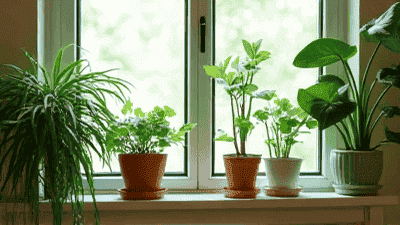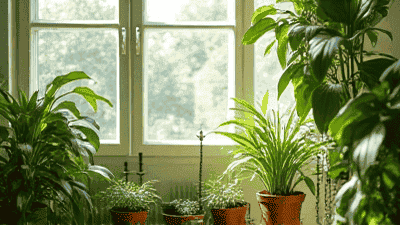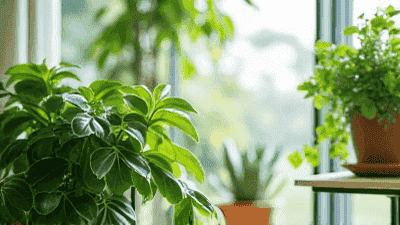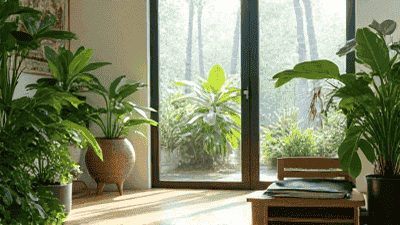
As concerns about air quality and environmental sustainability continue to rise, many people are seeking natural solutions to enhance their living spaces. One effective and beautiful method for improving indoor air quality is the incorporation of indoor plants. Not only do these green companions add beauty to interiors, but they also play a significant role in cleaning the air, promoting well-being, and contributing to sustainable living practices.
Indoor plants refer to a wide variety of plant species that are cultivated indoors, either for decorative purposes or for their numerous health benefits. These plants contribute to a healthier indoor environment in various ways, making them an excellent addition to homes, offices, and public spaces.
One of the most significant benefits of indoor plants is their ability to improve air quality. Many indoor plants can purify the air by absorbing toxins, releasing oxygen, and increasing humidity levels. Research has shown that certain plants can effectively remove harmful substances like benzene, formaldehyde, and trichloroethylene from the air.
Indoor plants improve air quality through photosynthesis and a process known as phytoremediation. During photosynthesis, plants absorb carbon dioxide and release oxygen, enhancing the overall air quality. In addition, plants have specialized structures called stomata on their leaves that allow them to absorb various airborne pollutants.
Studies conducted by NASA and other research organizations have demonstrated the effectiveness of indoor plants in purifying air. The well-known NASA Clean Air Study identified several plants that excel in removing toxins from indoor environments. This study laid the foundation for understanding the importance of houseplants in promoting healthy air quality.
Beyond their air-purifying abilities, indoor plants also provide psychological and physiological benefits. The presence of greenery indoors can enhance mood, reduce stress, and improve overall well-being. Here are some key benefits you can expect from incorporating indoor plants into your living spaces:
Stress Reduction: Studies have shown that being around nature or indoor plants can significantly lower cortisol levels, reducing stress and promoting relaxation.
Enhanced Productivity: Indoor plants have been found to improve concentration and productivity. Many workplaces have started incorporating plants into their office environments to create a more engaging and motivating atmosphere.
Boosted Creativity: Exposure to green environments stimulates creativity and innovative thinking. This makes indoor plants ideal for creative workspaces.
Improved Sleep Quality: Certain plants, such as lavender, are known for their calming effects and can help enhance sleep quality by promoting relaxation.
Increased Humidity: Indoor plants naturally release moisture through a process called transpiration, which increases humidity levels. This can be beneficial for respiratory health, especially in dry indoor environments.

When it comes to selecting indoor plants for air quality improvement and sustainability, it's essential to consider factors such as light availability, maintenance requirements, and your personal preferences. Here are some popular indoor plants known for their air-purifying abilities:
The spider plant is an excellent choice for beginners due to its low maintenance requirements. This hardy plant thrives in various lighting conditions and is particularly effective at removing formaldehyde and xylene from the air. Spider plants produce "pups" or baby plants, making propagation easy and fun.
Peace lilies do well in low-light conditions and are known for their elegant white blooms. They effectively remove pollutants like ammonia, benzene, and formaldehyde. However, keep in mind that peace lilies are mildly toxic to pets, so ensure they are kept out of reach.
Also known as mother-in-law's tongue, the snake plant is an excellent low-light plant that requires minimal watering. It is particularly unique because it converts carbon dioxide into oxygen at night, making it an ideal choice for bedrooms. The snake plant is also effective at filtering pollutants like formaldehyde and nitrogen oxides.
The Boston fern thrives in humid environments and requires consistent moisture. This lush plant is known for its ability to remove formaldehyde and other toxins from the air while adding humidity, making it beneficial for respiratory health.
Aloe vera is not only known for its health benefits but also for its air-purifying properties. This succulent absorbs formaldehyde and benzene and is low-maintenance, thriving in bright, indirect light. Additionally, its gel can be used to soothe minor burns and skin irritations.
The rubber tree is a popular indoor plant known for its large, glossy leaves. It is effective at removing toxins from the air, especially formaldehyde. Rubber trees thrive in bright, indirect light but can tolerate lower light conditions as well.
The ZZ plant is a hardy indoor plant that can tolerate low light and neglect. Its waxy leaves are excellent at absorbing carbon dioxide and releasing oxygen. The ZZ plant is also known for its resilience and adaptability to different environmental conditions.
Once you have selected the right indoor plants for your space, it is essential to consider how to incorporate them effectively. Here are some tips for creating a thriving indoor garden:
Observe the light conditions in different areas of your home before placing your plants. Most indoor plants prefer bright, indirect light, but some can thrive in low-light conditions. Place plants accordingly to ensure they receive the appropriate amount of light.
To add visual interest to your indoor garden, arrange plants at varying heights. Use plant stands, hanging baskets, or shelves to create layers in your indoor landscape.
Group plants of similar care requirements together to create mini indoor ecosystems. This not only makes maintenance easier but also promotes humidity and airflow among the plants.
Select pots that complement your interior design while providing adequate drainage for the plants. Decorative pots can enhance your home's aesthetic and elevate the overall appearance of your indoor garden.
If space is limited, consider using vertical planters or wall-mounted shelves to display your plants. This is an excellent way to add greenery to small spaces while maximizing available area.
Rotate plants and change their placements with the seasons. Some plants may benefit from more sunlight in the winter months, while others may require shadier conditions in the summer. Regularly assess and adjust their positions to keep them happy and thriving.

Caring for indoor plants is essential to ensure they thrive and continue to improve your indoor air quality. Here are some general care tips for maintaining healthy indoor plants:
Overwatering and underwatering are common challenges for indoor gardeners. Here are some guidelines:
Most indoor plants thrive in higher humidity levels, especially tropical varieties. If the air in your home is dry, consider the following options:
Indoor plants benefit from regular fertilization to ensure they receive essential nutrients. Here are some tips on fertilization:
Regular pruning encourages healthy growth and creates a more attractive appearance. Follow these guidelines for effective pruning:
Indoor plants can attract pests such as aphids, spider mites, or mealybugs. Implement these strategies to manage pest infestations naturally:
Incorporating indoor plants into your living space contributes to a sustainable lifestyle. Here’s how indoor plants play a role in promoting sustainability:
By growing your own indoor plants, you can reduce your reliance on store-bought flowers and foliage that have been transported long distances, thereby decreasing your carbon footprint.
Creating indoor gardens enhances biodiversity in urban areas. By introducing plants to your interior spaces, you provide habitats and food sources for beneficial insects, thus promoting a diverse ecosystem.
When you propagate plants from cuttings or division, you reduce waste associated with purchasing new plants. Sharing plants with friends and family also promotes a culture of sustainability and resource-sharing.
Indoor plants positively impact mental well-being, contributing to a healthier lifestyle. By promoting a calming and peaceful environment, plants help alleviate stress and anxiety, fostering a sense of sustainability and connection to nature.
Incorporating indoor plants provides opportunities for learning about ecosystems, plant care, and sustainable practices. Engaging children and family members in gardening activities nurtures a sense of environmental responsibility.

Indoor plants play a vital role in improving air quality, enhancing well-being, and contributing to sustainable living practices. By carefully selecting the right plants, incorporating them into your home, and providing proper care, you can create a thriving indoor garden that benefits both you and the environment.
Whether you are a seasoned gardener or just starting your journey, the incorporation of indoor plants can have a transformative impact on your living space. Embrace the beauty and benefits of indoor greenery, and come to appreciate the invaluable role that plants play in promoting a healthier and more sustainable world.